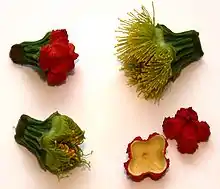Operculum (botany)
In botany, an operculum (plural opercula) is a cap-like structure in some flowering plants, mosses, and fungi.


Flowering plants
In flowering plants, the operculum, also known as a calyptra, is the cap-like covering or "lid" of the flower or fruit that detaches at maturity. The operculum is formed by the fusion of sepals and/or petals and is usually shed as a single structure as the flower or fruit matures.[1]
In eucalypts, (including Eucalyptus and Corymbia but not Angophora) there may be two opercula - an outer operculum formed by the fusion of the united sepals and an inner operculum formed by the fusion of the sepals. In that case, the outer operculum is shed early in the development of the bud leaving a scar around the bud. In those species that lack an outer operculum, there is no bud scar. The inner operculum is shed just before flowering, when the stamens expand and shed their pollen.[2]
In some species of monocotyledon, the operculum is an area of exine covering the pollen aperture.[3]
In Plantago, the capsule has an opening covered by an operculum. When the operculum falls, the seed is sticky and is easily carried by animals that come into contact with it.[4]
Pitcher plants have an operculum above the pitcher that serves to keep out rainwater that would otherwise dilute the digestive juices in the pitcher.[5]
Mosses
The sporangium of mosses usually opens when its operculum or "lid" falls off, exposing a ring of teeth that control the release of spores.[6]
Fungi
There are two types of sexual spore-bearing asci of ascomycete fungi - those that have an operculum at the top of the ascus, and those that do not.[7]
References
- "Glossary of Botanical Terms". Royal Botanic Garden Sydney. Retrieved 27 December 2019.
- "Learn about eucalypts". Euclid: Centre for Australian National Biodiversity Research. Retrieved 27 December 2019.
- Furness, Carol A.; Rudall, Paula J. (January 2001). "Pollen and anther characters in monocot systematics". Grana. 40 (1–2): 17–25. doi:10.1080/00173130152591840.
- Kuiper, Pieter J.C. (ed.); Bos, Marten (ed.); Soekarjo, R. (1992). Plantago: A multidisciplinary study. Berlin: Springer-Verlag. pp. 6–12. ISBN 3540536329. Retrieved 27 December 2019.CS1 maint: extra text: authors list (link)
- "The giant plants that eat meat". BBC. Retrieved 27 December 2019.
- "Form and function". Encyclopædia Britannica, Inc. Retrieved 27 December 2019.
- Reynolds, Don R.; van Brummelen, J. (1981). Ascomycete Systematics : the Luttrellian Concept (Chapter 3 - The Operculate Ascus and Allied Forms). New York: Springer-Verlag. pp. 27–31. ISBN 9781461258469.